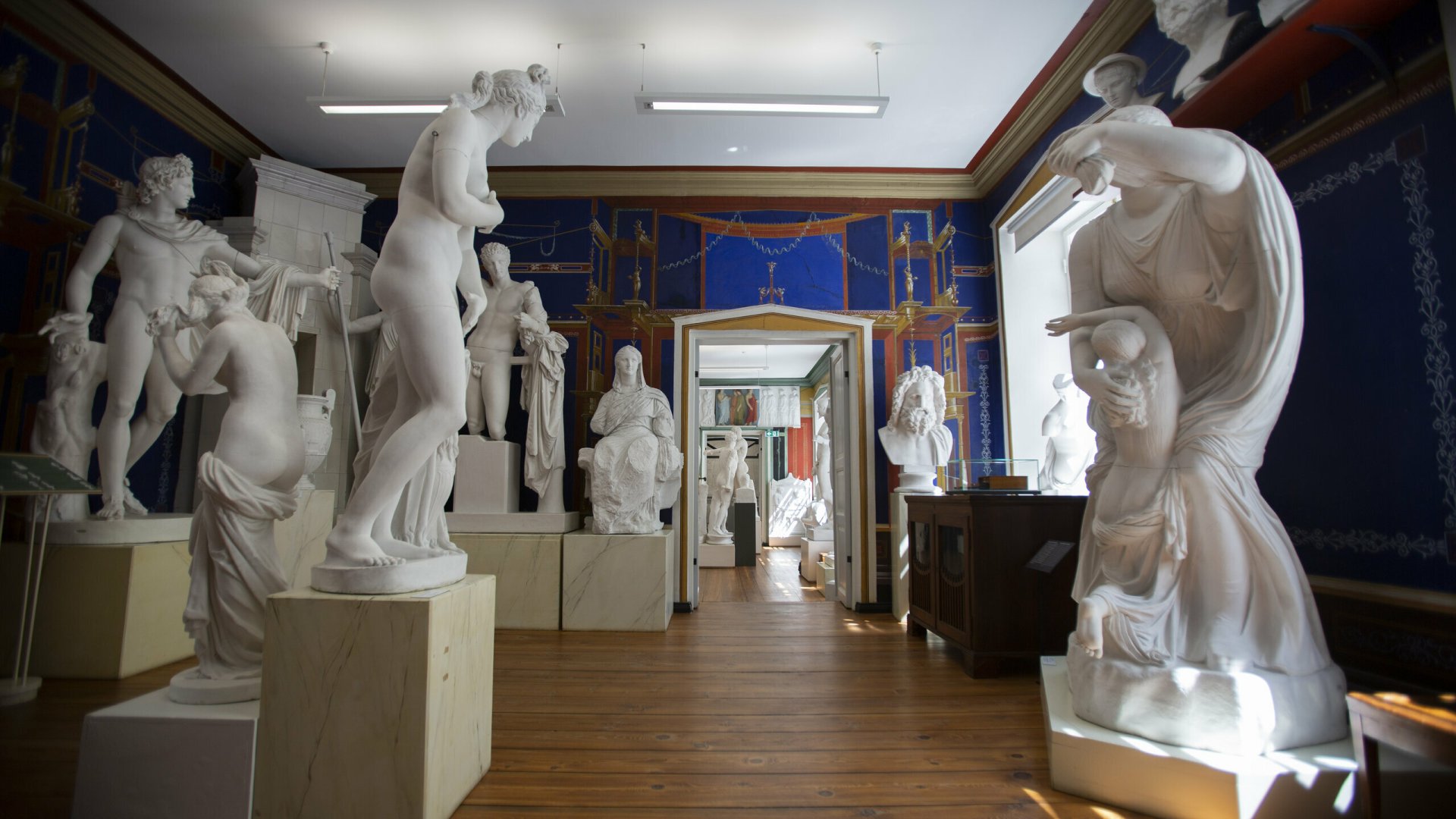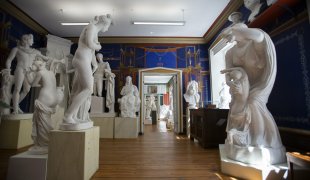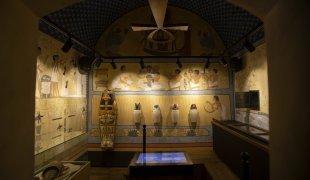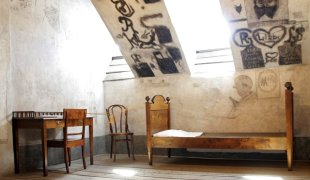The University of Tartu Art Museum permanent exhibition
The University of Tartu Art Museum has the only permanent exhibition of antique art and real mummies in Estonia. On the same ticket, you can also visit the university’s assembly hall and the old student lock-up in the attic.
The best works of antique art
The University of Tartu Art Museum has the only antique art exhibition in Estonia. The exhibition consists of original size plaster-cast copies of the greatest sculptures from Archaic, Classical and Hellenistic Greece. They were acquired in the 1860s from museums in England, Germany, France and Italy in order to promote students’ interest in and knowledge of art, history and culture.
The backdrop of the exhibition consists of ornamental Pompeian-style murals, which were painted in 1868 when the museum moved into its current residence in the left wing of the University of Tartu main building. It is the oldest interior specially designed for a museum in Estonia. These colourful wall paintings accentuate the white plaster sculptures.
The rare original death mask of philosopher Immanuel Kant (1724–1804) is also on display. Another copy of it is known to exist.
Mummy Chamber
In the Mummy Chamber, visitors will find two genuine mummified humans and a mummified canine, all of them from Egypt. The mummies are the only pieces left from the Egyptian collection of the University of Tartu after the rest of the collection was evacuated to Voronezh, Russia in 1915. The mummies are from the collection of one of Estonia’s first orientalists, Otto Friedrich von Richter (1791–1816). When Richter’s father gave his son’s collection to the university, he wanted it to be available to young people and to inspire them to discover and explore the world.
The hall is adorned with wall paintings inspired by Egyptian tombs, telling stories of the afterlife that was highly desired by the ancient Egyptians as well as the rituals associated with funerals.
Visitors can view the fascinating sarcophagus and models of canopic jars, which, on closer inspection, offer information on how and for what purpose they were used.
The University of Tartu Assembly Hall
The assembly hall can be visited with a museum guide. The assembly hall, with its classical beauty, is one of the most imposing rooms in the university. The official opening of the main building was held on 31 July 1809. Since then, the assembly hall has been the venue for all the university’s great events, from graduations and celebrations to numerous concerts.
In 1965, there was a great fire in the main building, which also severely damaged the assembly hall. The assembly hall is the heart of the university and an important symbol so it was restored very soon after the fire. This was done following Johann Wilhelm Krause’s initial plans.
The lock-up
In the attic of the main building is the historical lock-up room. This was originally used for detaining students who had offended public order and the code of student conduct. Punishments involving detainment in the lock-up were meted out by the University Tribunal and detainment could last from a few days to three weeks. Many students registered their time in the lock-up by using whatever tools were available to carve drawings, verses or monograms into its walls, ceiling and doors.
In 2018 the University of Tartu Art Museum supplemented its lock-up cell with a new exhibition that tells stories of the misdeeds of 19th-century students. The exhibition provides an insight into the most common offences at the University of Tartu in the last decades of the 19th century as well as the punishments. The writings on the walls also provide a fascinating glimpse into the minds of the students who were detained there.
Accessibility
Getting there
- The permanent exhibition is in the University of Tartu Art Museum on the first floor of the university’s main building.
- A wooden ramp can be used to help cross elevated areas in the Art Museum.
- The assembly hall is on the second floor of the building, also accessible by elevator.
- The lock-up is in the attic of the building, accessible only by a narrow wooden staircase.
Seating
- The exhibition rooms, the assembly hall and the hallways of the main building have several chairs and benches with backs.
Light and sound
- There is no background music in the art museum’s permanent exhibition (except for the Mummy Chamber), the assembly hall or the lock-up.
- The Mummy Chamber has continuous background music.
- The art museum’s permanent exhibition and the assembly hall have plenty of natural light.
- The Mummy Chamber has artificial lights and is lit rather dimly.
Read about the accessibility of the entire building here.
Project teams
Exhibition team: Jaanika Anderson, Ingrid Sahk, Kristiina Tiideberg, Külli Valk, Anne Arus, Maria Väinsar, Liisi Pabstel
Project manager: Jaanika Anderson
Adviser: Janet Laidla (University of Tartu)
Interior design: Mari Kurismaa
Wall paintings: Kristiina Ribelus and Pille Vilgota
Sarcophagus and models of canopic jars: Eike Eplik, Anne Arus, Arvi Kuld
Furniture: Wako Värkstuba
Translation of texts: Mari Eller, Yaroslava Shepel
Computer software: OÜ ZED
Curators: Kristiina Tiideberg and Ken Ird
Designer: Silver Vahtre
Exhibition poster design: Maarja Meeru
Translators: Mare Rand, Kristin Lillemäe ja Jaroslava Šepel
Technical production: Tanel Nõmmik
Programmes for the audience: Kristiina Tiideberg, Ken Ird and Paula Põder
Educational programme: Külli Valk
Support: Cultural Endowment of Estonia




